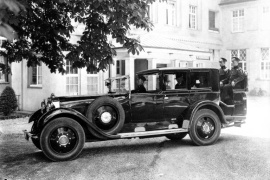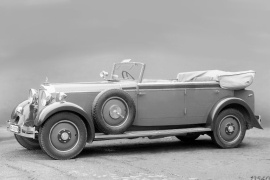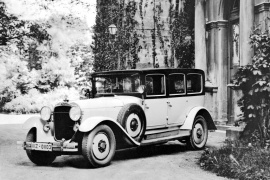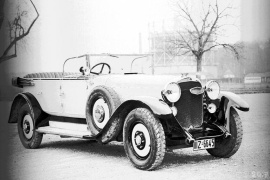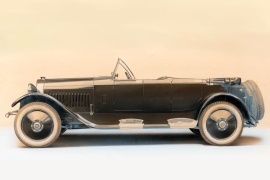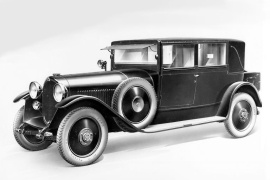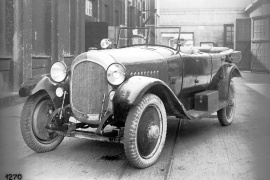MAYBACH Typ W1, W2, W3, W5 and W5 SG Models/Series Timeline, Specifications & Photos
First production year: 1919
Engines: Gasoline
By 1928, Maybach vehicles were very known in the luxury car segment, and the customers were concerned about their safety, so the car manufacturer offered them an option: the W5 SG.
The owners of the expensive cars were concerned. Some admired them, some envy them, and others just wanted to steal from them or kidnap them for a ransom. They needed protection, and Maybach didn't want to make the cars even heavier. The government already required a CDL driving license due to their weight, and adding armor plating was not an option. Maybach approaches the problem differently: it built a designated area for security guards.
The W5 SG featured the same bodywork as the regular W5. At the front, the carmaker installed a sturdy bumper in front of the wheels. It mounted them directly on the chassis. The owners could have chosen an even thicker bumper that could blast through a roadblock. The vehicle's tall radiator sat in a protected area, above the front axle with a chromed surrounding. Its front fenders were shorter than on other cars from that era. Behind the closed cabin, Maybach installed an additional bench where two security guards could sit and watch above the car's hood.
The interior was typical for a Maybach. It provided expensive leather seats, wood trims, and a communication tube to ask the driver where to go and when to stop. The guards behind the cabin were exposed entirely, allowing them to jump and fight if needed or sit and shoot from above.
Under the hood, Maybach used the same inline-six engine as on the W5. Its seven-liter displacement received a new carburetor and higher compression ratio, raising the power to 120 hp, which was a lot for those times.
Maybach needed a new vehicle to stay ahead of its competition, and the W3 model was not exactly up to the task, so Karl Maybach introduced the W5 in 1928.
When the W3 came on the market in 1921, it was an advanced car for its time, but seven years later, it was already old. Customers asked for more, and the carmaker felt obliged to deliver. Thus, Maybach introduced the W5 in 1926, followed by the upgraded, open-top version SG in 1928.
It was not just a convertible version for the already known W5 but an evolution that could've been seen from the exterior. The front fascia featured a slightly V-shaped grille with a metallic mesh in front of the radiator and a chromed surrounding. Its headlights were supported by vertical brackets instead of a horizontal slat, like other cars from that era. Maybach chose to install shorter front fenders instead of the elongated ones and placed the spare wheels behind them on each side of the engine's compartment. At the back, behind the cabin, the carmaker placed the trunk, which was accessible from the outside.
Inside, the luxurious cabin offered room for four people. The rear ones were spoiled with footrests, a folding table, and even a retractable glass panel between the front and rear seats. Boasting cranked windows was yet another luxury option for those times when many cars were still offered without any side windows. But not Maybach.
Under the hood, the carmaker installed its newest engine. The seven-liter inline-six powerplant provided 120 hp, 50 more than the W3 model. Yet, due to the heavy construction, its performances were not astonishing. But the car also featured a critical improvement in the braking department, where power-assisted drum brakes in all corners made it far safer than its predecessor.
Designed as a super luxurious vehicle, the Maybach W5 was the ultimate luxury vehicle built in 1926 in Germany, and it was not only elegant by those times' standards but also fast thanks to its big engine.
Germany was at the forefront of technology with a booming economy, and the upper-class customers asked for more. Mercedes-Benz tried to offer them the best of what it got, but it couldn't match what Maybach developed and provided. So even though customers could go to private coachbuilders and get their vehicles tailored to their needs and desires, the German carmaker still offered the W5 as a final product.
The W5 was an evolution over the W3 model and tried to offer more from room and power. Its torpedo bodywork started with curved, slim fenders above the front wheels that supported the electric headlights. The front overhang was short and protected by a narrow bumper-mounted directly on the chassis in front of the leaf springs. Unlike many other cars from the same era, it featured side windows on all doors, not only at the back. Moreover, the windshield was cleaned thanks to a pair of upper-mounted wipers.
Inside, there was plenty of room in the back, thanks to the bench mounted above the rear axle. The driver benefited from a wooden dashboard, and center-mounted dials encircled in chromed trims. As usual, at this level, the upholstery was made from genuine leather and offered a high level of comfort.
The engine was an inline-six powerplant with two camshafts. Even though it provided 50 more ponies than the W3, due to the increased mass of the vehicle, it was just slightly faster than the W3 model, and one of the reasons was the two-speed transmission.
By 1926, Maybach was already a recognized premium car manufacturer, and the W5 was the ultimate luxurious product for the German brand.
While its main competitor, Mercedes-Benz, offered plenty of vehicles in various shapes and sizes, Maybach tried to keep up with it and offered a convertible version for the W5. Unfortunately for the carmaker, it didn't have the same production capacity as its Stuttgart-based competitor and, moreover, couldn't sell at lower prices. In addition, the three-pointed-star brand still had the advantage of a better chassis.
The W5 featured a short overhang protected by a narrow bumper mounted directly on the chassis in front of the leaf springs. For the cabin, the carmaker installed a flat, vertical windshield with a pair of wipers mounted at the top. For better wind protection, Maybach added a set of windows at the sides for the front passengers. The rear occupants, on the other hand, were exposed to elements when the top was down. Maybach also thought about it and created side window panels that were mounted on the rear doors, although that solution worked only when the top was up.
Inside, there was plenty of room in the back, thanks to the bench mounted above the rear axle. The driver benefited from a wooden dashboard and center-mounted dials encircled in chromed trims. As usual, at this level, the upholstery was made from genuine leather and offered a high level of comfort. The retractable canvas top could have been folded down behind the rear seats.
The engine was an inline-six powerplant with two camshafts. Even though it provided 50 more ponies than the W3, due to the increased mass of the vehicle, it was just slightly faster than the W3 model, and one of the reasons was the two-speed transmission.
In 1921 Maybach introduced its first production vehicle, the W3, at the Berlin Motor Show and offered it with a choice of bodyworks or as a rolling chassis.
Karl Maybach tried his engineering skills when he made the W1 prototype, but mostly for the drivetrain since he used a chassis from a Daimler vehicle. After that, he created a new base for its next vehicle, the W3. Strangely, there was no W2 model, and the W letter came from the word "Wagen," which means "car" in German.
The new vehicle enjoyed limited success, and none of them survived. Still, older pictures and advertising materials from those times did. Besides the closed bodywork version, Maybach also built several convertible versions for the W3. Like its sedan sibling, the open-top model featured a long engine compartment fitted with side vents to help cool the inline-six powerplant. The car featured side steps on the sides to help occupants with ingress and egress. The straight-up windshield was fitted with wipers, so the car could be driven during the rain. The torpedo bodywork was fitted with four doors, and depending on the version, the rag-top could've been retracted behind the cabin. Also, on the sides, the automaker installed mounting points for the spare wheels.
The interior was created with exclusive, expensive materials. Karl Maybach understood that such an expensive vehicle should have been fitted with luxurious amenities. He also installed two seats at the front and a wide, comfortable bench in the rear. So even though it wasn't the most beautiful car on the market, it was still one of the most elegant.
Under the hood, the automaker installed an inline-six powerplant that developed 70 PS from its 5.7-liter displacement. Maybach paired it with a two-speed manual gearbox that sent the power to the rear wheels.
Maybach introduced its first production model at the 1921 Berlin Motor Show, and it was available as a rolling chassis, an open-top tourer, and a closed-body vehicle.
After creating the W1 prototype, Karl Maybach understood what he had to do to create a successful model. Thus, it worked harder not only on the engine but also on the rest of the vehicle. Since the first prototype, the W1, was based on a Daimler touring car from the military surplus, the automaker could understand where he could improve it and make it better for its next project. Strangely, there was no W2 model, so he jumped directly to the W3. The W letter in the nameplate came from "Wagen" (Car in German).
While sadly, none of the W3 vehicles produced survived, older pictures and materials from those times' press showed us a squared-looking bodywork with a chromed or body-colored surrounding for the radiator. The long engine compartment featured side vents to help cool the inline-six engine. Since it relied on a tall chassis, the W3 Closed bodywork needed a set of side steps to help the ingress and egress to the vehicle. Maybach created a unique shape for the front doors, with an arched line on the forward side.
The interior was created with exclusive, expensive materials. Karl Maybach understood that such an expensive vehicle should have been fitted with luxurious amenities inside. He also installed two seats at the front and a wide, comfortable bench in the rear. Even though it wasn't the most beautiful car on the market, it was still one of the most elegant.
Under the hood, the automaker placed an enhanced version of the W2 inline-six engine that offered 70 PS. It paired it with a two-speed gearbox that sent the power to the rear wheels.
When Wilhelm Maybach decided to step into the automotive segment by founding his own car company, it began with this: the W1 test vehicle.
In the aftermath of WWI, Germany was not allowed to build military aircraft and other kinds of vehicles. Still, they were allowed to produce passenger cars and light trucks. But Maybach aimed higher and understood that high income comes from luxury vehicles. Yet, he has to start from somewhere. With help from his son, Karl Maybach, they used an older Daimler chassis and started building on it.
Even though the W1 was intended to be more of a mule than a finished vehicle, Wilhelm Maybach didn't do things halfway. It created a complete bodywork with curved side panels and hood, which were unusual for those times. Moreover, he placed a mesh grille in front of the radiator and fixed it into a rounded-shaped thick rim. From its sides, the vehicle revealed its majestic look, for those times, with its torpedo body style. In addition, a two-piece vertical windshield protected the occupants from wind. Access was made via two narrow doors at the front and two in the back, and all were rear-hinged. The ragtop was stored behind the cabin. Since it was a test vehicle, it didn't sport any spare wheels, although it featured a toolbox placed on the left side of the vehicle onto the sidestep.
The cabin featured a pair of seats at the front and a bench in the rear. The four-spoke steering wheel was on the right side of the car, while the center-mounted dials showed various information about the car, such as speed, temperature, fuel level, and revs.
Under the hood, Maybach installed a newly developed inline-six powerplant that was very powerful for those times. It was rated at 46 hp, which was just enough to prove it was worthy of being installed in a production vehicle. And that came in 1921 at the Berlin Motor Show bearing the W3 name.
